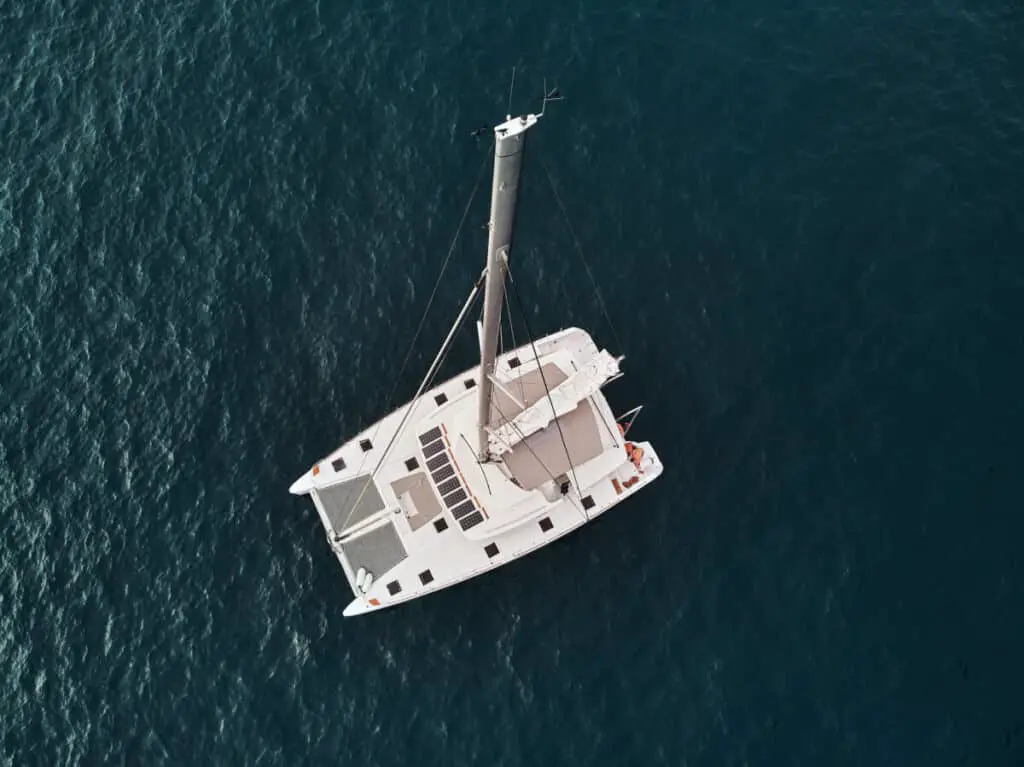As an Amazon Associate, we earn from qualifying purchases. We may also earn commissions if you purchase products from other retailers after clicking on a link from our site.
Sailing, for those who know it well, is an activity that can be enjoyed by pretty much anybody out there. It is a very freeing, invigorating experience that is sure to leave you wanting more, plus, it might even be useful for traveling if you are capable of packing light. However, catamarans (and other sailboats) do have their limits, so the question is, how far can you sail a catamaran in one day without needing a restock of supplies?
Most catamarans and other sailboats can travel up to 100 nautical miles (NM) in a day, which equates to about 115 miles total. If the boat is downwind and the engine is used, it could likely travel as much as 130 NM (150 miles) in a day. The speed and length will differ slightly based on wind strength.
Imagine what fun it is going to be when you take your catamaran out for the day and head off into the unknown with the wind in your face. However, before you set sail, it is indeed important to know the limits as well as the safety precautions of sailing in a catamaran. Read on to learn a few tips and tricks which will hopefully help you to set sail with complete confidence!

Catamaran Sailing: How Long Should I Stay Out?
As mentioned earlier, most modern catamarans can sail up to 130 NM in a single day, depending on where you are sailing to and how well the wind cooperates. Catamarans are also equipped with engines, however, so if you were to use that engine, it would help get you a little farther.

For reference, a transatlantic crossing (more on that here) is around 2880 NM. 2880 NM divided by 100NM per day equals 28 days (roughly 4 weeks). But remember! This is only possible if there is wind, and crossing the Atlantic might involve days or weeks with no wind. Especially in the area called “doldrums” near the equator.
Generally, you should be able to keep your catamaran out to sea for up to four weeks, though it is recommended that you clean it thoroughly if you’ve been sitting in saltwater for that long. Barnacles and other sea creatures will attach themselves to the hulls of your catamaran and that will get annoying to deal with after a while.
When and how long you should take your catamaran out depends greatly on the weather and your experience. If you are still inexperienced and have had little practice, you ought to probably stay as close to home as possible rather than venturing out into the great unknown by yourself. Plus, in the event of inclement weather, you ought to be extra careful. Better safe than sorry.

What Should I Take?
Knowing how to pack for a catamaran sailing trip is essential, especially since you don’t want to overdo it. Packing everything you own? Not a good idea. What you should do is bring plenty of weather-appropriate clothes (usually clothes you’d wear during the summer) and pack them in a duffel bag or some other soft bag.
Hard luggage will scratch your boat up pretty quickly. You should probably also include something warm to wear at night. It can get chilly out there at sea so make sure you’re well-equipped for whatever may come. Pack like a minimalist and you should be good to go.
Don’t forget to pack any necessary accessories. Bring towels, toiletries, sunglasses, and plenty of sunscreen. You should avoid bringing any kind of valuables (jewelry, electronics, etc.) with you, especially if said valuables are not waterproof. The only electronics you should bring are cameras or cellphones and extra batteries or solar chargers.
You should also think about bringing some books or games or something to keep you busy because when you’re not out in the sea breeze, you’ll be inside the cabin with not a whole lot to do. Again, pack as lightly as you can, but be sure to bring what you need to stay busy and entertained.
Make sure you bring plenty of food and snacks. Obviously, for a long trip, you’d want to more carefully plan your meals and pack accordingly. If you’re just out to hit the waves for a day or two, you should be able to survive on snacks such as chips, veggie sticks, dips, fruit, meat cuts, and whatever else you might fancy.
Sailing Recommendations/Tips

Now that you know what you need to bring and how you should pack, it is probably best that we talk about a few tips for sailing. Catamaran sailing must be undertaken carefully, even for the most experienced sailor. Here are a few tips that might help you to be ready for whatever comes!
The first thing you ought to know when sailing is not to get cocky. Safety should always come first, no matter how experienced you are. If it looks like the weather may not cooperate, you probably ought to stay home. It might prove that there’s nothing worse than being out at sea in the middle of a storm.
You should also be sure to let the anchor down whenever you’re not sailing. Catamarans have a lot of area towards the wind so they will easily drift downwind, and fast. Whenever you stop for a break, be sure to let the anchor down so you don’t drift with the tide, as that can cause you to become lost. This is a fairly easy habit to develop and it only takes a minute, so don’t become careless with the anchor.
And speaking of taking breaks, do so as frequently as needed. Don’t get cocky and think you can make it for so many hours without taking a break because you, like your boat, have limits. If you start to feel fatigued, that’s a sign that you need to stop for a while and rest. Just make sure you’re dropping the anchor when you do so.
As mentioned earlier, catamarans have engines, usually two. Running the engines will help your sailboat to go faster, but running them both at once will not make the boat go much faster than running one. Run one engine at a time. This way, if you have one engine burn out, you will not get stranded because you will have the other to rely on.
You can read more about safe sailing practices here!
